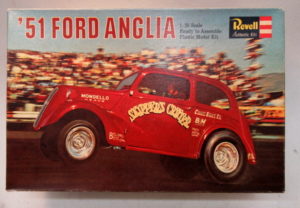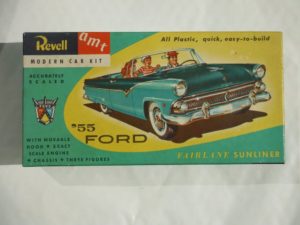
Aargh, I write a column ONCE. But due to fumble-fingeredness, I lost my original copy of today’s column. So here goes try #2:
Boys love two things: building things, and cars. So it was kind of a no-brainer decision by Revell founder Lewis H. Glaser in 1947 to take advantage of the new technology of molded plastic in order to create model car kits.
Revell, located in Venice, California, had enjoyed moderate success in the toy market up until that point. But Glaser’s farsighted decision would make them giants in the model car market until our present day, not to mention selling millions of plastic molded kits for airplanes, military equipment, sailing ships, modern-day ships, and countless other objects requiring the help of a human and airplane glue to achieve completion. But today, we concentrate on the Revell model cars.
Here’s how the scenario would unfold: A kid would convince his mom or dad that he just couldn’t live without his Revell muscle car model. The relenting parent would part with the $2.99 or so to purchase the prize. The kid would unwrap the plastic outer covering on the ride home, and take out each immaculate sheet of plastic parts attached to frames with each part number stamped next to its owner.
When he got home, here’s where modelers would go one of two paths. You either painted the parts with bright Testors enamel and a tiny brush, or you just got started creating your Camaro.

I was of the latter persuasion. I didn’t have the patience to sit around and let enamel dry. That carries forth to the present day in my type-A personality. No, I needed to start separating parts and creating an automobile.
Of course, life lessons were taught, as was the case with so many of our playthings. For instance, you didn’t separate ALL of the plastic parts at the outset, or you wouldn’t know where some of the smaller, more obscure parts went. And you didn’t glue parts together until you were SURE they went together, because that airplane glue didn’t react nicely to having cemented parts pulled apart. It showed its rage by eating and deteriorating the parts themselves.
You were also neat with your glue, because it would dry clear, but manifest itself by making a child’s fingerprints obvious once dust began collecting on the model.
But we learned the lessons, and had a wonderful time assembling model cars out of some amazingly detailed plastic parts.
Even today, we might get a chance to exercise what we learned as children when our wives bring home furniture that requires assembly, or perhaps a new bike for a grandchild. Slow down and follow the instructions, even though you might think that any moron should be able to transform a flat box full of parts into a computer desk.
Perhaps one day, when i have some free time, I’ll reward myself for the accomplishment with a Revell model 1968 Camaro kit.
When I was a very young man, I befriended the owners of a hobby shop in the town I lived in. I used to run errands for them, and once in a while they would pay me to clean the nose and fingerprints off the glass fronted display cases. About one day a week Peggy would tell me of the new models that came in and would show me the boxes.
Like a lot of boys in my age group, (under 10) I didn’t have the patience to paint the models, and I’m afraid, I too, was not very good at glue application. When finished, my models weren’t real presentable. Some years later, my best friend taught me a lesson in patience and helped me build a model I was very proud of. It was a 1963 Ford Falcon Ranchero. I painted that model, and even put real naugahyde on the seat. Years later, my very first new car was a 69 Ford Ranchero. Different color scheme than my model, but I was real proud of that model when it was done. It was probably the last one I built, but it was done right for a change.